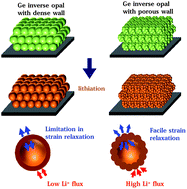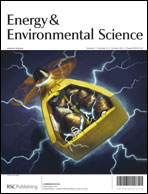A Ge inverse opal with porous walls as an anode for lithium ion batteries†
Abstract
Germanium holds great potential as an anode material for lithium ion batteries due to its large theoretical energy density and excellent intrinsic properties related to its kinetics associated with lithium and electrons. However, the problem related to the tremendous volume change of Ge during cycling is the dominant obstacle for its practical use. The previous research has focused on the improvement in mechanics associated with lithium without consideration of the kinetics. In this study, we demonstrate that the configuration engineering of the Ge electrode enables the improvement in kinetics as well as favorable mechanics. Two types of Ge inverse opal structures with porous walls and dense walls were prepared using a confined convective assembly method and by adjusting Ge deposition parameters in a chemical vapor deposition system. The Ge inverse opal


 Please wait while we load your content...
Please wait while we load your content...